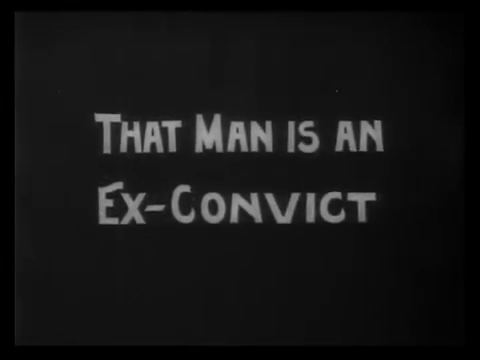US / 9 minutes / bw silent / Edison Manufacturing Company Dir & Scr & Cine: Edwin S. Porter Story (uncredited): Number 973 (n.d. play) by Robert C. Hilliard and Edwin Holland Cast: uncredited.
One of a string of short movies made by the Edison studio under the direction of Edwin S. Porter (1870–1941), often (although seemingly not in this instance) in uneasy partnership with Wallace McCutcheon. Some of the movies, including this one, addressed matters of social concern. In their notes for their four-DVD collection Edison: The Invention of the Movies, King Video/MoMA describe The Ex-Convict thus:
An uncredited but quite obvious adaptation of a well-known vaudeville piece, Number 973, by Robert Hilliard and Edwin Holland. Starting from the Hilliard–Holland one-act playlet, Porter visualized the storyline into a total of eight scenes. Unlike Uncle Tom’s Cabin [the studio’s 1903 take on the Harriet Beecher Stowe classic, also included in the DVD set], The Ex-Convict was not filmed theater but an adaptation that took advantage of the filmmaker’s ability to place a scene in an appropriate location (outside a store, home, or factory, and on the street) and to move quickly from one setting to the next. The naturalistic locales and the accelerated pace heightened the emotional intensity of the viewer’s reaction to the pathetic story, achieving a level of realism impossible on the stage. In the process of adaptation, Porter also added important new elements, notably the ex-convict’s family.
Our unnamed protagonist, having done his time in the Big House, is determined to go straight and earn an honest living to support his wife and ailing child. He gets a job, but is soon recognized in the street by a malicious cop, with the result that he’s summarily fired. Thereafter no one will hire him because of his past and his lack of references.
Come the bleak midwinter, he’s reduced to begging in the street. When even that proves unsuccessful, he finally gives in to the temptation to return to his old thieving ways. Luckily the first house he breaks into is that of the rich family of a little girl whom, at great personal hazard, he months ago saved from getting run over by a car. All seems set for a happy ending . . .
Even after MoMA’s restoration, the print quality is not high, as you’ll gather from the screengrabs here. However, the short remains very watchable, I think largely because of that naturalism King/MoMA mentioned, a naturalism Porter was able to achieve through the then new art of location shooting. The opening sequence—the ex-con comes down the steps of his dwelling, bids farewell to his family and sets off for work—is simplicity itself, yet, thanks to such mundane details as a vehicle passing by in the background, it immediately draws us into the tale: we’re persuaded this is reality rather than merely a performance. The staging of the rescue of the little girl, while not especially well choreographed, nonetheless has enough vigor and drama that I was prepared to forgive a lot.
There are several copies of this vintage short on YouTube.
Silent movies with the same name, The Ex-Convict, were released in 1913 and 1914, but so far as I can ascertain they bear no relation to this one aside from the obvious thematic overlap the title would imply.



10 minutes well spent over the morning coffee
Yep. It’s a surprisingly engaging piece, I’d say.